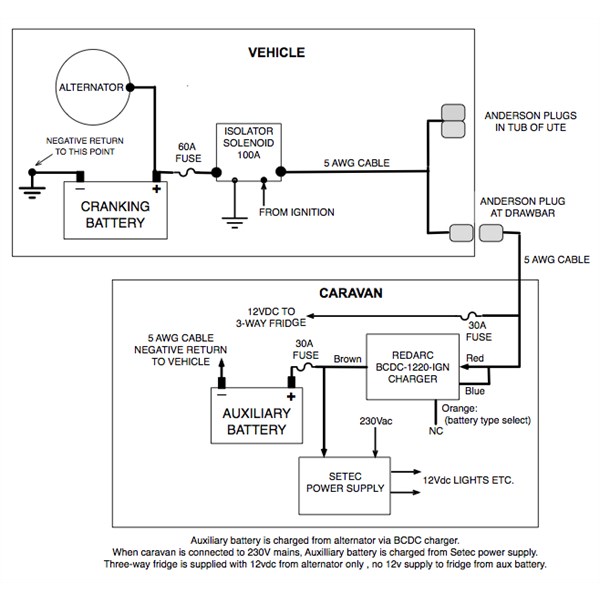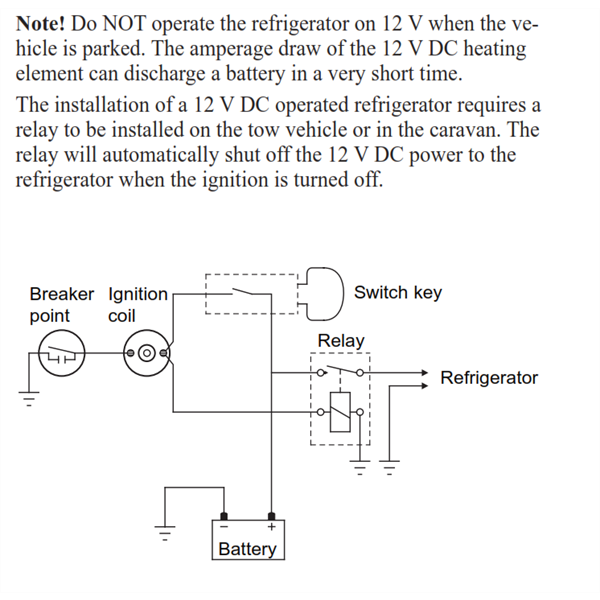Fridge Switches . How sensitive .
Submitted: Tuesday, Jun 27, 2017 at 17:29
ThreadID:
135165
Views:
6077
Replies:
4
FollowUps:
13
This Thread has been Archived
Geoffr17
Hi.
I know these work on movement when you are driving and allow power to the 3 way fridge.
I can not find any info on how much movement/ vibration is needed to turn them on.
My slight concern is stopping the car , switch in van goes off , we then enter van and start moving around making lunch , washing up , using
toilet etc , would this movement make the fridge switch think we were driving and turn back on.
Thanks.
Reply By: AJC - Tuesday, Jun 27, 2017 at 18:48
Tuesday, Jun 27, 2017 at 18:48
Hi Geoff,
There's one made by RV Electronics and it seems from the instructions that it works on jolts rather than just movement - but as you point out, what's going to actually trigger it on, is a bit of a
grey area.
The instruction manual says:
CONTACT R V ELECTRONICS FOR MORE DETAILS.
PHONE 08 82613500 FAX 08 82613400 EMAIL info@rvelectronics.com.au
May be a good idea to hear it direct from them.
Cheers,
AJC
AnswerID:
612195
Reply By: Allan B (Sunshine Coast) - Tuesday, Jun 27, 2017 at 22:35
Tuesday, Jun 27, 2017 at 22:35
.
They are activated by lateral movement. That is, the sideways movement of the van when in motion on the road.
I doubt that they would activate by normal personal movement within the van.
Of course, it may operate if subject to an significant regular rhythm. lol
Note that they incorporate a time delay of a minute or so in order to not switch off with short vehicle stops, so the fridge may
well be running when you step into the van after driving.
AnswerID:
612200
Reply By: Kazza055 - Wednesday, Jun 28, 2017 at 17:29
Wednesday, Jun 28, 2017 at 17:29
Never really like the idea of a fridge switch so have always just used an ignition relay - fridge runs while the engine is turned on.
Can't get any simpler than that.
AnswerID:
612214
Follow Up By: Geoffr17 - Wednesday, Jun 28, 2017 at 19:28
Wednesday, Jun 28, 2017 at 19:28
I not sure how this would work.
Power runs direct from car battery to the anderson plug at rear.
Fridge wire runs from anderson at front of van to fridge.
How does the relay cut the power , the fridge switch stops the power by sensing no movement when car is stopped.
It just goes in the fridge line.
FollowupID:
882393
Follow Up By: Kazza055 - Wednesday, Jun 28, 2017 at 20:42
Wednesday, Jun 28, 2017 at 20:42
Very simple Geoffr17, the relay only operated when the ignition is on and the power from the battery is run through the relay contacts.
Engine not running, no 12V supplied to the Anderson plug - KISS.
FollowupID:
882396
Follow Up By: Batt's - Thursday, Jun 29, 2017 at 08:41
Thursday, Jun 29, 2017 at 08:41
Geoff the relay is usually wired to the accessories side of the ignition switch which activates it when key is turned On/ Off. It's a basic older style set up which works
well as there are a lot more electronics involved these days that we put our faith in which work
well if quality products are used for reliability and safety. I prefer old style which can be fixed easier and cheaper if something goes wrong as mentioned above the KISS principle.
FollowupID:
882407
Follow Up By: Kazza055 - Thursday, Jun 29, 2017 at 08:56
Thursday, Jun 29, 2017 at 08:56
Just to reiterate, my relay does not come on with accessories, it is wired to the ignition. This means that it only supplies 12V while the key is in the ignition position i.e. engine is running.
The only way I could drain the battery is if the key was in the ignition position without the motor running which is very unlikely.
FollowupID:
882408
Follow Up By: Geoffr17 - Thursday, Jun 29, 2017 at 09:03
Thursday, Jun 29, 2017 at 09:03
Thanks for the info guys.
So the relay will require additional wiring to ignition circuits etc , now I see.
The fridge switch requires no extra wiring , just cut the wire to the fridge and wire it in.
I appreciate your answers and the relay is probably a proven method , but I still do not see how it is simpler.
Again thanks for the info , I will do one or the other for sure.
FollowupID:
882409
Follow Up By: Allan B (Sunshine Coast) - Thursday, Jun 29, 2017 at 09:29
Thursday, Jun 29, 2017 at 09:29
,
You are quite right Geoff.
The ignition relay method works
well enough but does require not only a relay but also a wire from the car ignition circuit to the van via the plug at the rear of the car. I see that as more difficult than a Fridge Switch.
Take note though of the following instruction from the makers of Fridge Switch.
This same precaution is also necessary if using an ignition-controlled relay.
IF YOUR CARAVAN IS FITTED WITH A FRIDGE THAT REQUIRES 12 VOLTS TO IGNITE THE GAS, EG: DOMETIC MODELS RM4211AND RM4401 , EXTRA WIRING NOT SHOWN IN THESE INSTUCTIONS MAY BE NEEDED.
CONTACT R V ELECTRONICS FOR MORE DETAILS.
PHONE 08 82613500 FAX 08 82613400 EMAIL info@rvelectronics.com.au
FollowupID:
882410
Follow Up By: Kazza055 - Thursday, Jun 29, 2017 at 10:25
Thursday, Jun 29, 2017 at 10:25
The reason I go for the relay over the fridge switch is simple, if the relay fails I do not end up with a flat battery.
If the fridge switch fails, it could very easily fail in the on position and result in a dead battery and not being able to start the engine.
The wiring required for the relay is very minimal and can be done with a piggy back fuse plugged into any ignition supply - a five minute job.
FollowupID:
882411
Follow Up By: Frank P (NSW) - Thursday, Jun 29, 2017 at 11:03
Thursday, Jun 29, 2017 at 11:03
I use an isolator in the car to energise the Anderson only when the engine is running and a dc-dc charger in the van which acts as an isolator there and ensures the van Anderson is not live when disconnected from the car.
If I want an IGN controlled source in the car I use the cold side of the isolator. This avoids any canbus issues that may arise from piggy-backing off an IGN controlled fuse in the vehicle fusebox.
If I want an IGN controlled source in the van, I use the Anderson input terminal.
Cheers
FollowupID:
882412
Follow Up By: Allan B (Sunshine Coast) - Thursday, Jun 29, 2017 at 13:37
Thursday, Jun 29, 2017 at 13:37
.
Frank, that sounds very much like a system that I recently designed and installed for a friend.
The schematic for it is below.
The Setec power supply was existing in the caravan so was retained for supplying the 12v lighting when being connected to 230v mains.
The solenoid isolator at the cranking battery is not a voltage-dependant (or 'Smart') isolator, just a simple solenoid controlled by the ignition. A simpler and better method.
In order to cope with a variable-voltage alternator I used a Redarc BCDC1220-IGN and by strapping the Redarc's blue ign sensing wire to the red +12 input it sensed the 'ignition' availability via that line. As the fridge is connected to that same +12v supply line from the vehicle, the fridge is de-energised when the ignition is off and can drain no batteries.
The Anderson sockets in
the tub are for an extra aux battery and fridge using another redarc dc-dc charger which isolates that battery from everything except its fridge.
The Anderson socket at the rear of the vehicle is 'dead' when the vehicle is parked so no one can fool with it.
The system has worked perfectly for my friend.
In Kazza's case, ignore the Setec.
FollowupID:
882416
Follow Up By: Frank P (NSW) - Thursday, Jun 29, 2017 at 15:42
Thursday, Jun 29, 2017 at 15:42
Can't see the schematic, Allan, but here's the schematic for my system FYI. It may be useful for you too, Graeme, though I think you have yours pretty
well worked out.
Like all electrical schematics it look complicated, but it's not really, except for:
a) I chose a "smart" isolator because the solenoid draws about half an amp which may have done canbus things if piggybacked off an IGN source in the fusebox, and
b) I have incorporated a change-over relay so that the fridge and 1 aux socket run off the alternator when the engine is running and off the second battery when it's not.
I did this because I prefer the dc-dc charger not to have to deal with cyclic loads as the fridge cuts in and out.
This has worked perfectly for the 2 and a half years I've had the car.
Cheers

Aux power system
FollowupID:
882417
Follow Up By: Allan B (Sunshine Coast) - Thursday, Jun 29, 2017 at 16:42
Thursday, Jun 29, 2017 at 16:42
.
Sorry Frank, I edited the text and inadvertently deleted the image.
I'll try again.
I understand your concern re Canbus fragility and clearly your isolator is OK, but as "smart" isolators depend on battery terminal voltages for their operation, issues can arise with vehicles that have voltage-controlled alternators. There are a number references to this on the Redarc site.
Seems to me that an owner of any 4WD will wish to install a number of accessories requiring control by the ignition switch, so to avoid loading the ignition circuit a solution could be to install an 'accessory' fuse block supplied from the battery via a conventional 30 Amp relay whose coil is connected to the ignition circuit. Connected accessories are then entirely isolated from any Canbus. The aux battery isolator can then be fed from this distribution fuse block.
I too have a changeover relay to transfer the fridge directly to the alternator during auxiliary battery charging so that the load is not carried by the dc-dc charger.
I'll try with the schematic again. BTW, This is not my vehicle.

Schematic for 'Smart' alternator dual-battery.
FollowupID:
882420
Follow Up By: Frank P (NSW) - Thursday, Jun 29, 2017 at 17:32
Thursday, Jun 29, 2017 at 17:32
It's tidier when you use a pictorial diagram like that, Allan :-)
My "smart isolator" is actually a big (300A continuous) dumb solenoid activated by a Redarc adjustable voltage sensitive relay (VS12). Its operating range of 9V to 16V is adequate for voltage-controlled alternators. As a bonus the VS12 plus a reputable brand (Cole-Hersee) dumb solenoid from eBay works out cheaper than a Redarc SBI and has a higher continuous current rating than Redarcs largest :-)
Cheers
FollowupID:
882421
Reply By: Nomadic Navara - Thursday, Jun 29, 2017 at 21:14
Thursday, Jun 29, 2017 at 21:14
Why spend excessive money of expensive devices when a $10 to $15 relay will do the trick. i have been using a headlight relay and towed the van for over 150,000 km. Wire the fridge as Dometic recommend.

Dometic wiring diagram.
AnswerID:
612231
Follow Up By: Nomadic Navara - Thursday, Jun 29, 2017 at 21:18
Thursday, Jun 29, 2017 at 21:18
We have all assumed you have a MES fridge and not one of the later AES models. If your fridge is an AES (auto energy selection) model it does not require any switching in the main 12 V power line, it just requires a light wire from the ignition switch run circuitry to the 'D' terminal on your fridge.
FollowupID:
882431